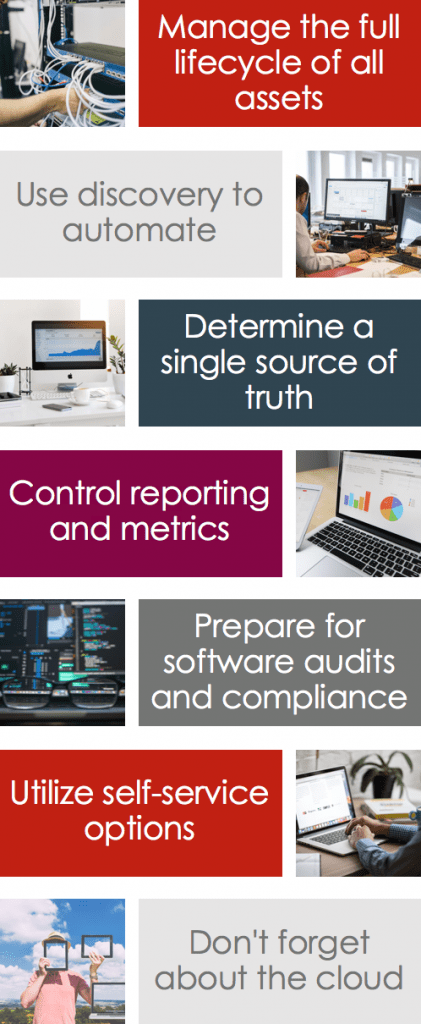 So what makes a successful IT Asset Management program? Or, if we want to go back even a step further, what is Asset Management, and why does it matter?
So what makes a successful IT Asset Management program? Or, if we want to go back even a step further, what is Asset Management, and why does it matter?
IT Asset Management is the system through which an enterprise joins financial, contractual, and inventory functions to support lifecycle management and strategic decision making for the IT environment. These include:
- Hardware, often called Real, Assets. Computers, heavy equipment, machinery, and data centers are all considered hardware assets.
- Software, often called Virtual, Assets. In opposition to real assets, virtual assets are things such as email accounts, software licenses, and any virtual machines.
As you can imagine, or may already know, the management of these assets is essential to any enterprise, and mistakes result in significant unplanned expenses. In fact, we’ve covered this very topic extensively in the past.
A successful Asset program saves money and increases utilization by avoiding these unplanned expenses, reducing overall asset management efforts. Furthermore, the program provides critical visibility to help you make more insightful business decisions. Let’s look at the critical components…
A successful program manages the full lifecycle of all assets.
Asset lifecycles are often very predictable, something that works heavily in your favor. From this, you can build an IT Asset Management plan to cover everything from start to finish, including:
- Planning assets you need
- Negotiating contracts with vendors
- Setting up assets for use
- Making assets available for use
- Tracking where assets go
- Logging asset use activity
- Retiring assets when they are no longer in use
With an asset management plan, you will no longer be reacting to incidents but instead, you will be able to forecast and automate these processes.
A successful program uses discovery to automate.
We all know the company that uses spreadsheets across their entire organization. Who knows, that might even be your company. While it might seem overwhelming to change an entire system when it does in fact still work, it’s impossible to ignore the setbacks of these manual processes, such as; wasted time, suboptimal decision-making based on incorrect data, and other avoidable errors
To avoid these mistakes and optimize efficiency, Asset Management in ServiceNow utilizes automation, ensuring data accuracy in reporting. This also reduces management costs associated with keeping the information up to date and tracking the full lifecycle of assets (see above).
A successful program has a single source of truth.

Have you ever spent too much time looking for information, building reports, and making decisions without the right data to back it up?
Asset management is often no different. By tracking assets in multiple spreadsheets (scattered across various computers no less), you are missing the benefits of having a single source of truth.
Linking your asset repositories to a service management system means you’ll be capable of tracking assets throughout their entire lifecycle and actually keep records current.
A successful program has control of reporting and metrics.
With a single dashboard view, ServiceNow’s reporting allows any Asset team to make the best possible strategic decision for controlling and utilizing their assets. This means you will be able to quickly:
- Diagnose problems
- Benchmark performance
- Develop targeted action plans
A successful program prepares for software audits and compliance.
Periodic testing confirms that all internal and external compliance are met, while notifications for contract owners prevent lapses in coverage.
A successful program has self-service options.

Companies are increasingly ‘consumerizing’ their employee experiences, due to demands of the digital age. If you are using manual processes instead of an employee self-service you:
- Discourage employees from making requests.
- Have difficulty tracking asset utilization, and therefore cannot predict future needs.
- Reduce productivity of employees who cannot get what they need.
Instead, by providing a service portal for employee use, you are able to deliver consumer experiences that will provide both the employees and the asset teams with status updates as requests go through fulfillment.
A successful program doesn’t forget about the cloud.
Virtual assets are really no different than your real assets. They also require lifecycle tracking and financial management. Avoid VM sprawl, unplanned costs, and availability issues by utilizing tools such as orchestration to automate public and private cloud assets.
Meet Our ServiceNow Asset Experts

Carleen Carter, Director of Architecture, has experience as both a user of IT software and an administrator of the ServiceNow platform. With a unique ability to architect complex solutions and processes that are still simple and intuitive for end-users, her specialties include custom architecture, user experience-driven development, asset management, procurement, contract management and request/CMDB.

Shaun Brachmann, Senior Technical Consultant, is an IT Professional with experience that includes: Enterprise Infrastructure, System Administration, Network Administration, Configuration Management, Asset Management, Enterprise Software, and Technical Training. He has designed and implemented many CMDBs for Fortune1000 companies using ServiceNow, Discovery, and other integrations.

Wally Waltner, Senior Business Process Consultant, was the owner of global IT Asset Lifecycle processes for a leading payment processor’s enterprise infrastructure supporting 25,000 employees, responsible for implementing hardware and software asset management best practices and leading a team of 10 direct and indirect resources for maintenance of the ITAM technical infrastructure along with process documentation.
Do you think your asset management program may be missing some of these critical components? Reach out to one of our ServiceNow experts to get a full evaluation, and potentially save thousands.
NOTE: This content was originally posted by Sarah Carley on August 2nd, 2018 on the Acorio website at https://www.acorio.com/successful-asset-management/ The Acorio brand retired in April 2023 after acquisition by NTT DATA. Some links may no longer work.

